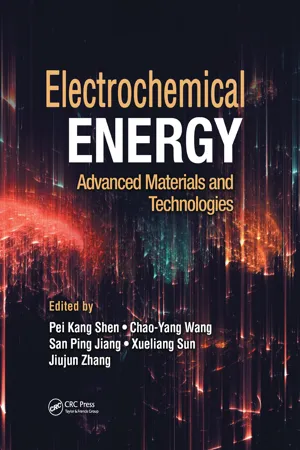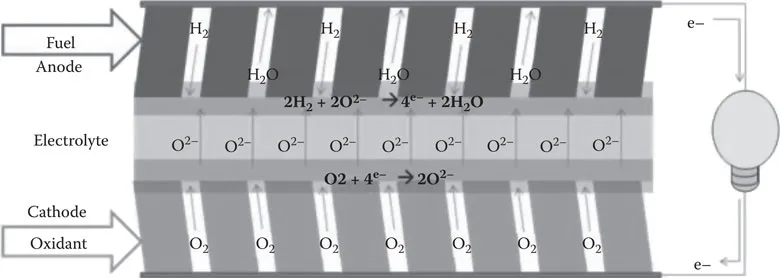
Electrochemical Energy
Advanced Materials and Technologies
- 622 pages
- English
- ePUB (mobile friendly)
- Available on iOS & Android
Electrochemical Energy
Advanced Materials and Technologies
About this book
Electrochemical Energy: Advanced Materials and Technologies covers the development of advanced materials and technologies for electrochemical energy conversion and storage. The book was created by participants of the International Conference on Electrochemical Materials and Technologies for Clean Sustainable Energy (ICES-2013) held in Guangzhou, China, and incorporates select papers presented at the conference.
More than 300 attendees from across the globe participated in ICES-2013 and gave presentations in six major themes:
- Fuel cells and hydrogen energy
- Lithium batteries and advanced secondary batteries
- Green energy for a clean environment
- Photo-Electrocatalysis
- Supercapacitors
- Electrochemical clean energy applications and markets
Comprised of eight sections, this book includes 25 chapters featuring highlights from the conference and covering every facet of synthesis, characterization, and performance evaluation of the advanced materials for electrochemical energy. It thoroughly describes electrochemical energy conversion and storage technologies such as batteries, fuel cells, supercapacitors, hydrogen generation, and their associated materials. The book contains a number of topics that include electrochemical processes, materials, components, assembly and manufacturing, and degradation mechanisms. It also addresses challenges related to cost and performance, provides varying perspectives, and emphasizes existing and emerging solutions.
The result of a conference encouraging enhanced research collaboration among members of the electrochemical energy community, Electrochemical Energy: Advanced Materials and Technologies is dedicated to the development of advanced materials and technologies for electrochemical energy conversion and storage and details the technologies, current achievements, and future directions in the field.
Frequently asked questions
- Essential is ideal for learners and professionals who enjoy exploring a wide range of subjects. Access the Essential Library with 800,000+ trusted titles and best-sellers across business, personal growth, and the humanities. Includes unlimited reading time and Standard Read Aloud voice.
- Complete: Perfect for advanced learners and researchers needing full, unrestricted access. Unlock 1.4M+ books across hundreds of subjects, including academic and specialized titles. The Complete Plan also includes advanced features like Premium Read Aloud and Research Assistant.
Please note we cannot support devices running on iOS 13 and Android 7 or earlier. Learn more about using the app.
Information
12 | Advanced Materials for High-Temperature Solid Oxide Fuel Cells (SOFCs) |
12.1 | Introduction | ||
12.2 | Solid Electrolytes | ||
12.2.1 | Oxygen-Ion Conductors with Fluorite-Type Structure | ||
12.2.1.1 | Doped Zirconia or Zirconium Oxide | ||
12.2.1.2 | Ceria or Cerium Oxide | ||
12.2.1.3 | Bismuth Oxide | ||
12.2.2 | Perovskite Structure | ||
12.2.3 | Proton Conductors | ||
12.2.3.1 | Proton Conductors with Perovskite Structure | ||
12.3 | Anode of SOFCs | ||
12.3.1 | Requirements of Anode | ||
12.3.2 | Development of Anode Materials | ||
12.3.2.1 | Conventional Ni–YSZ Cermet Anode Materials | ||
12.3.2.2 | Other Cermet Anode Materials | ||
12.3.3 | Conducting Oxides | ||
12.3.3.1 | Perovskite Anode Materials | ||
12.3.3.2 | Pyrochlore Anode Materials | ||
12.3.3.3 | Tungsten Bronze Anode Materials | ||
12.3.4 | Sulfur-Tolerant Anode Materials | ||
12.4 | Cathode | ||
12.4.1 | Category of the Cathode Material | ||
12.4.1.1 | Perovskite-Type Structure Cathode Materials | ||
12.4.1.2 | Ln1−xAxM1−yMnyO3-δ, Where Ln = La, Nd, Pr, etc., A = Ca, Sr, and M = Transition Metal | ||
12.4.1.3 | Other Ln1−xAxM1−yMnyO3-δ | ||
12.4.1.4 | La1−xSrxCoO3-δ | ||
12.4.1.5 | La1−xSrxFe O3-δ | ||
12.4.1.6 | La1−xSrxFe1−yCoyO3-δ | ||
12.4.2 | K2NiF4-Type Structure Cathode Materials | ||
12.4.3 | Ordered Double Perovskites | ||
12.4.4 | Surface Modification | ||
12.4.4.1 | Mixed Ionic–Electronic Conductor (MIEC) | ||
12.4.4.2 | Noble Particle Deposition on MIEC Cathode | ||
12.4.4.3 | Thin Film Coating on MIEC Cathode | ||
12.4.5 | Summary | ||
12.5 | Interconnect | ||
12.5.1 | Ceramic-Based Interconnect | ||
12.5.2 | Metallic Interconnect | ||
12.5.2.1 | Problems for Metallic Materials as Interconnect | ||
12.5.2.2 | Excessive Growth and Spallation of Oxide Scale | ||
12.5.2.3 | Chromium Poisoning | ||
12.5.3 | Contact Resistance of Metallic Interconnect | ||
12.5.4 | Materials for Metallic Interconnects | ||
12.5.4.1 | Chromium-Based Alloys | ||
12.5.4.2 | Fe–Cr-Based Alloys | ||
12.5.4.3 | Ni–Cr-Based Alloys | ||
12.5.5 | Modification Coating | ||
12.5.5.1 | Nitride Coatings | ||
12.5.5.2 | Perovskite Coatings | ||
12.5.5.3 | Spinel Coatings | ||
12.5.6 | Summary | ||
References | |||


Table of contents
- Cover
- Half Title
- Title Page
- Copyright Page
- Table of Contents
- Series Preface
- Preface
- Editors
- Contributors
- SECTION I Overview of Electrochemical Energy Storage and Conversion
- SECTION II Advanced Materials and Technologies for Lithium-Ion Rechargeable Batteries
- SECTION III Advanced Materials and Technologies for Metal–Air Rechargeable Batteries
- SECTION IV Advanced Materials and Technologies for Lead–Acid Rechargeable Batteries
- SECTION V Advanced Materials and Technologies for Fuel Cells
- SECTION VI Advanced Materials and Technologies for Supercapacitors
- SECTION VII Advanced Materials and Technologies for Liquid–Redox Rechargeable Batteries
- SECTION VIII Advanced Materials and Technologies for Water Electrolysis Producing Hydrogen
- Index